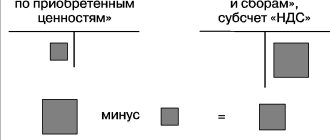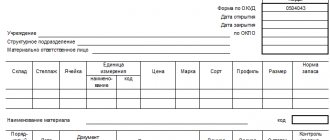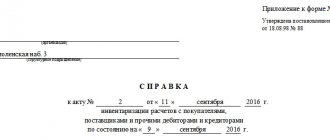Insurance
If there are insurance operations for employees and property, subaccount 76 of account is used - 76.1.
It is worth noting that this does not take into account the costs associated with the calculation and payment of wage insurance premiums. Payments are calculated in correspondence with cost accounts. These may be production costs (20, 25, 26 and others) or other expenses not related to production activities (account 91). Examples of insurance transactions:
| Dt | CT | Purpose of the operation |
| 20 | 76.1 | Insurance premiums have been calculated for insured production equipment |
| 76.1 | 51 | Transfer of insurance amounts |
| 91.2 | 76.1 | Other assets not involved in the production process are insured |
| 76.1 | 91.1 | Calculation of insurance compensation |
| 51 | 76.1 | Insurance amount received |
| 76.1 | 73 | The amount of insurance compensation has been accrued in favor of the injured employee |
| 51 | 76.1 | The insured amount was reimbursed |
| 73 | 51 | The employee received insurance compensation |
Example 1. Production equipment is insured for the amount of 300,000 rubles. Every month the organization accrued and paid insurance amounts in the amount of 2,000 rubles. Some time later, a fire occurred that destroyed the insured asset. The insurance company agreed to pay compensation. Typical entries are as follows:
- Dt 20 – Kt 76.1 (2,000 rubles) – calculation of the monthly insurance amount.
- Dt 76.1 – Kt 51 (2,000 rubles) – transfer of the insured amount.
- Dt 76.1 - Kt 91.1 (300,000 rubles) - the compensation amount was accrued as a result of the occurrence of an insured event.
- Dt 51 – Kt 76.1 (300,000 rubles) – compensation received.
Example 2. An employee previously insured against industrial accidents was injured in the workplace. The amount of compensation from the insurance company was 150,000 rubles. Previously, insurance amounts in the amount of 800 rubles were transferred monthly. The following entries have been generated in accounting:
- Dt 20 – Kt 76.1 (800 rubles) – accrual of the insured amount for transfer to the insurance company.
- Dt 76.1 – Kt 51 (800 rubles) – transfer of insurance premium.
- Dt 76.1 – Kt 73 (150,000 rubles) – reflection of the amount payable for insurance compensation.
- Dt 51 – Kt 76.1 (150,000 rubles) – receipt of funds to the organization’s account.
- Kt 73 – Dt 51 (150,000 rubles) – insurance compensation was paid to the victim.
The concept of accounts payable in the budget and its reflection in accounting
Accounts payable are the obligations (debts) of a legal entity to other business entities, credit organizations, the budget and extra-budgetary funds.
It is reflected in the liabilities of the balance sheet on line 1520 and includes calculations:
- With buyers;
- With suppliers;
- With a budget;
- With extra-budgetary funds (for various types of social insurance);
- With employees on wages;
- With founders and participants (for payment of dividends, interest and other income);
- With accountable persons;
- With creditors and debtors for other debts (for example, for advances received under contracts).
Accounts payable to the budget include obligations for taxes and fees. Moreover, this can be either an overdue accounts payable or a current one, the payment deadline for which has not yet arrived. how to write off accounts payable.
To reflect the situation with the payment of taxes and fees, active-passive account No. 68 is used. His loan takes into account the amount of taxes and fees accrued and indicated in the declarations (“debts” to the budget). For example, posting Debit 99 Credit 68 (hereinafter referred to as D and K, respectively) means that income tax has been accrued. A D 70 K 68 - personal income tax (NDFL).
The debit of the account reflects taxes and fees paid (debt repayment). In particular, posting D 68 K 51 means payment of any tax from the current account of the enterprise.
- The credit balance at the end of the reporting period means that a legal entity is indebted for taxes and fees.
- Debit - indicates budget debts to an enterprise (company) or - overpayment of tax payments.
Claims settlements
If counterparties violate their obligations, the injured party, in accordance with the provisions of the current agreement, has the right to claim compensation by filing a claim. Usually, subaccount 76.2 is used for these purposes. The parties' claims are reflected in the following entries:
| Dt | CT | |
| 76.2 | 60 | The requirement to suppliers for unfulfilled obligations before accepting the goods for accounting is reflected |
| 76.2 | 10, 41 | A shortage was detected after the goods were accepted. |
| 76.2 | 91.1 | Penalty accrued in case of violation of payment or delivery obligations |
| 51 | 76.2 | Receipt of compensation for submitted claims |
| 62 | 76.2 | Received a complaint from the buyer |
| 10, 41 | 76.2 | The buyer discovered a shortage after receiving the goods |
| 91.2 | 76.2 | The organization was assessed a fine from the counterparty after failure to comply with the terms of the agreement |
| 76.2 | 51 | A settlement has been made for the received claim. |
In some cases, it is not possible to receive payment for submitted claims. As a rule, we are talking about the following situations:
- lapse of time;
- liquidation of the debtor;
- cancellation of requirements by court decision;
- reaching a mutual agreement.
Unpaid obligations are written off from account 76 to the reserve for doubtful debts account or recognized as a loss.
Example 3. According to the terms of the contract, the supplier is presented with a claim in the amount of 6,000 rubles for late delivery and 36,000 rubles for receiving goods of inadequate quality. It was not possible to collect a fine of 36,000 rubles, as the court rejected the request. The supplier paid the other debt. The following entries will appear in the purchasing organization's accounting:
- Dt 76.2 – Kt 91.1 (6,000 rubles) – the amount of the fine (penalty) was assessed.
- Dt 51 – Kt 76.2 (6,000 rubles) – the penalty is paid by the supplier.
- Dt 76.2 – Kt 60 (36,000 rubles) – a claim was made upon receipt of a defective product.
- Dt 94 – Kt 76.2 (36,000 rubles) – the amount of the claim is reflected as a shortage.
Types of accounts receivable
Types of receivables are distinguished based on their classification criteria:
| Criterion | Types of accounts receivable |
| In order of occurrence | Normal (arising within the framework of credit policy) Unjustified (arising from violation of requirements) |
| By timing of payment | Scheduled (repayment dates have not yet arrived) Overdue (repayment period has already arrived, but the debt has not been paid) |
| By length of delay | Overdue less than 45 days Overdue from 45 to 90 days etc. |
| According to the reality of collection | Real for collection Doubtful Hopeless |
Debit 76 Credit 51
Settlements with various debtors and creditors. Current accounts
- Such posting reflects various settlement transactions, but not settlements with buyers, customers, accountable persons and other entities for settlements with which the Chart of Accounts does not provide for separate accounts. For example, these may be transactions for settlements with banking institutions for accrued commissions for settlement and cash services, as well as settlements with other organizations for various types of services that are not directly related to the process of core activities, the costs of payment of which are included in the overhead , sales, administrative, financial, emergency and other expenses related to the reporting period, and not directly on the cost of products (goods, works, services). This type of settlement may, under certain conditions, include the cost of utilities, communication services, employee training costs, legal costs in the form of a lawyer and other miscellaneous expenses. Conducted on the basis of bank statements.
D51 K76. claims settlements
Example: For the supply of materials and equipment, the organization transferred an advance payment of 118,000, including VAT. Upon acceptance of goods, a shortage of 11,800 was revealed, including VAT. The supplier agreed to return the funds in the amount of the identified shortage.
D60 K51 118,000 – advance payment transferred
D10 K60 90,000 – reflects the cost of received materials
D19 K60 16,200 – VAT is reflected on the cost of received inventories
D76. settlements for claims K60 11,800 – the amount of the claim is reflected
D51 K76. settlements for claims 11,800 - return of funds by the supplier to account for the shortfall
Option 3. If by the time the shortage, damage to the goods is discovered, the supplier has overestimated prices in the payment documents or other errors in the supplier’s payment documents, the calculations have not yet been made, then payment is made minus the cost of the missing and damaged materials due to the fault of the supplier, of which the buyer notifies in writing supplier. In this case, unpaid amounts are not reflected in the accounts for settlements of claims and settlements with the supplier. Thus, in this situation, it is enough to capitalize the actual amount of materials received, and document the amount of the shortage, and not reflect it in any way.
3) Possible situations when the settlement of claims is submitted to the court. And the court does not recognize the guilt of the opposing party.
D94 K76.settlements of claims – reflects the court’s refusal to recover amounts of losses from suppliers and transport organizations previously presented to them in the form of a claim.
D99 K94 – amounts of shortages of materials in excess of the norms of natural loss are written off in the absence of guilty persons in cases where the court refuses to recover damages from the guilty persons due to the unfoundedness of the claim.
Example: During the acceptance of materials, a shortage was identified. The total cost of materials in the contract prices of the supplier was 500,000 rubles + VAT 90,000 rubles. The cost of missing goods amounted to 50,000 rubles, including 8,000 rubles within the limits of natural loss. TZR for this supply amounted to 5,900 rubles, incl. VAT 900 rub. A claim was sent to the supplier for a shortage of materials in excess of natural waste norms. The supplier acknowledged the claim. As a result, the parties agreed to proportionally reduce the buyer's debt for the materials supplied to him. In addition, the supplier agreed to partially reimburse transportation costs.
The amount of shortages amounted to 10% (50,000 total shortages ÷ 500,000 total materials, including a shortage within the norm of 1.6%, in excess of the norm - 8.4%).
The amount of TZR attributable to capitalized goods and shortages within the norms is 4,580 rubles. (5,000 × 91.6%). The amount of TZR attributable to shortages in excess of the norms is 420 rubles. (5,000 × 8.4%). VAT is distributed similarly on materials and goods and materials. The share of VAT that falls on capital goods and is subject to reimbursement from the budget is RUB 82,440. from the cost of materials (90,000 VAT × 1.6%) and 824 rubles. according to TZR (900 VAT from TZR × 91.6%) The tax amount for the part of materials missing in excess of the norms is: 7,560 rubles. from the cost of materials (8.4% of 90,000) and 76 rubles. according to TZR (8.4% of 900 rubles) Thus, the amounts of shortages in excess of the norms of natural loss will be included in the cost of the goods: 42,000 rubles, TZR 420 rubles. and VAT = 7,560 + 76. As a result, a claim in the amount of 50,056 rubles will be sent to the supplier of goods (42,000 rubles for shortage of materials in excess of the norms + 420 rubles for the TKR for shortages in excess of the norms + 7,560 rubles for VAT on the cost of shortages in excess of the norms + 76 rubles VAT on transport services in the share that accounts for shortages in excess of the norms).
D10 K60.supplier 450,000 – actually received materials are capitalized at the supplier’s price
D94 K60.supplier 8,000 – the shortage of goods is reflected within the limits of natural loss norms
D10.TZR K94 8,000 – shortage is included in the cost of materials within the limits of natural loss norms
D19 K60.supplier 82 440 – reflected input VAT on received materials
D10.TZR K60.carrier 4,580 – included in the actual cost of goods is the share of TZR related to received materials and shortages within the norms
D76. settlements for claims K60. carrier 420 - reflects the cost of TZR related to shortages in excess of the norms
D19 K60.carrier 824 – VAT is reflected on TZR related to registered goods
D76.settlements for claims K60.carrier 76 – VAT related to TZR is reflected in the amount of shortages in excess of the norms
D68 K19 83,264 (82,440 + 84) submitted for deduction of VAT on the cost of goods and TZR in the share of capitalized materials
D60.carrier K51 5,900 – payment for transport services has been made
D60 K76. settlements for claims 496 (420 transport services + 76 VAT) - the enterprise’s debt to pay for the purchased batch of materials was reduced by the amount of the claim
D60 K51 539 944 (450,000 rubles. materials that actually arrived + 8,000 rubles. shortage within the norms and we agreed with it + 82,440 rubles. VAT from materials that we recognized - 496 rubles. claim that the supplier recognized) - goods were paid for, taking into account excess shortages and part of the goods and materials compensated by the supplier.
In tax accounting, losses from shortages and damage during storage and transportation of goods within the limits of natural loss norms approved in the manner established by the Government of the Russian Federation are included in material expenses (subparagraph 2, paragraph 7, Article 254 of the Tax Code). Shortages and losses are formed taking into account the TZR related to these goods (clause 2, Article 254 of the Tax Code). With regard to damage to goods in excess of established norms, there is loss, and also in cases where norms of natural loss are not established by the relevant ministry in principle, “the Ministry of Finance together with its tax friends believe” that the cost of such goods and the share of TZR related to such goods is not can be taken into account for profit tax purposes (letter of the Ministry of Finance dated June 21, 2006 No. 03-03-04/01/538 and letter of the Federal Tax Service dated January 17, 2007 No. 20-12/004115.
Debit 76 Credit 76: what does it mean
If the posting of Dt 76 Kt 76 is made in the correspondence of accounts, this is an offset of mutual claims. When, for example, he buys stationery from, and from - ready-made semi-finished products for employee lunches, at the same time a debt arises to and - to. The Civil Code allows in this case to offset the obligations of 2 companies (Article 410 of the Civil Code of the Russian Federation).
To do this, the following conditions must be met:
- Direct presence of counterclaims. That is, companies must have at least 2 agreements between themselves: one of them is a creditor, and the other is a debtor. Likewise for .
- The requirements of companies must be uniform.
- Set-off is permitted upon the maturity of one of the companies' obligations. If the period is not specified in the contract or is determined by the moment of demand, offset can be made at any time.
The Civil Code of the Russian Federation requires for offset to be carried out an application from one of the parties to the transaction or the drawing up of an act of offset. Companies can also carry out a partial offset - for the amount of the smallest mutual debt.
On the date of receipt of the application for offset or signing of the act of offset, company accountants must make the following entry:
Dt 76 Kt 76 - for the amount of offset obligations (reflects the termination of the counter obligation to pay for goods, works, services by offsetting mutual claims).
Example 1
in the first quarter of 2021, I purchased archival racks worth RUB 441,250. And “Paper Yard” bought several used refrigerators for the office kitchen for 353,000 rubles. Based on the results of the quarter, as of March 31, 2016, the firms signed a netting act for RUB 353,000. Let us assume that “Fas” take into account transactions between themselves on account 76, since for both companies these transactions are not the main activity.
In the accounting records, both companies will reflect the offset as follows: Dt 76 Kt 76 - in the amount of 353,000 rubles. (offset has been made).
Then the initial debit balance on account 76 y as of 04/01/2016 will be 88,250 rubles. And the credit opening balance on the same day will be similar, that is, “Fastmil” will still owe “Bumazhny Dvor” 88,250 rubles.
What to do if the creditor has not paid his debt, read the article “Writing off accounts payable with an expired statute of limitations.”
Characteristic
As has already become clear, account 76 is used for settlement transactions with debtor and creditor counterparties, which are not subject to accounting in accounts 60-75. The special account 76 itself is active-passive, that is, on the reporting date plan it can have both a debit and a credit balance. If there is a debit balance, it means that the amount of liabilities has increased. If there was a balance on the loan, then the obligations were repaid. In this situation, the account is active and this opening balance based on debit and credit turnover also determines its ending balance.
Important! If the increase occurred in debit, then the balance is debit; if in credit, then the balance is credit. When there is a loan balance on the account, the register itself behaves as passive. Thus, the final balance is formed by the side of position 76 on which the increase was recorded. With a debit increase, the final balance is formed from the Dt of the account, and the credit balance - from the Kt.
Debit 76 Credit 51
An accountant can post Dt 76 Kt 51 in the following cases:
- Payment has been made for property or personal insurance of personnel. Dt 76.1 Kt 51 - 10,000 rub. The accountant paid the insurance company the annual fee for the employee's insurance. Then, when receiving money from the insurance company upon the occurrence of an insured event, the Fastmil accountant will make a debit entry to account 51 in correspondence with account 76. And the accrual of insurance compensation to the employee will be reflected by entry Dt 76 Kt 73.
- The accounts payable to the counterparty has been repaid. A company can record settlements with suppliers both on account 62 and 76. In practice, accountants most often record on account 76 secondary counterparties, settlements with which occur infrequently.
- The supplier is paid for the claim or fine. In this case, mutual fines of 2 companies can be offset by posting Dt 76 Kt 76.
Example 2
I discovered that one of the archival shelves purchased from Bumazhny Dvor was deformed. And Bumazhny Dvor, in turn, filed a claim for the short supply of refrigerators.
According to the agreement between the parties, they are obliged to pay the counterparty a fine in the amount of 10,000 rubles. and remove the goods at your own expense. However, Bumazhny Dvor has the right to expect to receive monetary compensation from Fastmil for shortfalls in delivery. The fine is 5,000 rubles. The parties signed an act of mutual settlement for part of the mutual claims in the amount of 5,000 rubles.
In accounting it will be reflected as follows: Dt 76 Kt 76 - in the amount of 5,000 rubles. (mutual claims between are taken into account).
The paper yard accountant will make the following entries in accounting:
- Dt 76 Kt 76 - in the amount of 5,000 rubles. (part of the fine is offset against the due monetary compensation);
- Dt 76.2 Kt 51 - in the amount of 5,000 rubles. (a fine was paid for the supply of low-quality archival shelving).
The difference between accounts receivable and accounts payable
Accounts receivable represent what is rightfully due to the organization, but has not yet been received. And if the organization itself owes it, then this is already accounts payable.
Regardless of the repayment period of the receivable, it belongs to the current assets of the organization. Not all types of receivables are reflected in the corresponding line of the balance sheet. For example, the debt of suppliers and contractors under contracts for the purchase or creation of non-current assets is reflected in the “Non-current assets” section.
Settlements on account 76: assignment agreement
Posting Dt 76 Kt 76 is drawn up by an accountant when concluding an assignment agreement or assignment of a claim. This is an agreement under which one company (assignor) sells to another company (assignee) the right to claim debt from a third company (Article 382 of the Civil Code of the Russian Federation). Moreover, the debtor does not appear in the assignment agreement itself. Let's look at an example of how settlements under an assignment agreement are accounted for by each participant.
Example 3
bought the right to demand debt from IP Kuznetsova E.I. The amount of debt of IP Kuznetsova E.I. is 400,000 rubles. Bumazhny Dvor sells this debt for 350,000 rubles.
Since before this transaction Fastmil owed 350,000 rubles, Bumazhny Dvor and Fastmil offset the debts to each other.
The accountant reflected the acquisition of debt as follows:
- Dt 58 Kt 76 - in the amount of 350,000 rubles. (the debt of individual entrepreneur E.I. Kuznetsova was acquired under an assignment agreement);
- Dt 76 Kt 76 - in the amount of 350,000 rubles. (the purchase of the debt of E. I. Kuznetsova was counted against the debt of Bumazhny Dvor).
If an individual entrepreneur transfers money, the accountant will make the following accounting entries: Dt 51 or 50 Kt 76 - in the amount of 400,000 rubles. (debt received from individual entrepreneur E. I. Kuznetsova).
The accountant will determine the financial result of the transaction as follows:
- Dt 76 Kt 91.1 - in the amount of 400,000 rubles. (the amount of repaid debt is included in the company’s income);
- Dt 91.2 Kt 58 - in the amount of 350,000 rubles. (the cost of the acquired right of claim is included in expenses).
The credit balance on account 91 is the company’s profit from the purchase of the debt of IP Kuznetsova E.I. in the amount of 50,000 rubles.
And what entries will be made by an accountant if the company received a loss from an assignment agreement, read the article “How can a new creditor take into account a loss when assigning claims?”
In turn, the Bumazhny Dvor accountant will reflect the receipt of money from the sale of stuck accounts receivable as follows:
- Dt 76 Kt 91.1 - in the amount of 350,000 rubles. (reflects the proceeds from the sale of the debt of IP Kuznetsova E.I.);
- Dt 91.2 Kt 62 - in the amount of 400,000 rubles. (the debt of individual entrepreneur E.I. Kuznetsova was written off).
“Paper Yard” received a loss of 50,000 rubles.
Documents on the basis of which the bank guarantee is reflected in accounting
Accounting requires documentary evidence of transactions. This rule also applies to bank guarantees. Although the law does not oblige the conclusion of a separate agreement for its execution (Chapter 23 of the Civil Code of the Russian Federation), credit institutions prefer to draw up a document - an agreement for issuing a bank guarantee.
IMPORTANT! This document is the basis of the accounting entry. Includes information about the amount, expiration dates, etc.
It is possible to draw up such an agreement electronically. It is certified with an electronic digital signature. The legal force of both versions of the document is the same.









